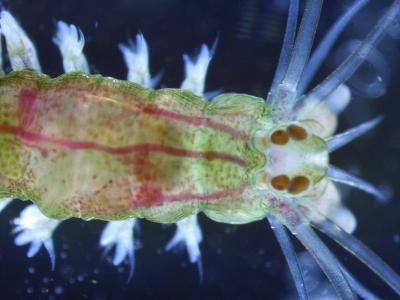Simple eyes consist of only two cells that lead the floating animal to the light
Researchers have figured out how the first evolutionary eyes work and how they guide the marine life to light.
Larvae of invertebrate marine animals such as worms, sponges and jellyfish have the simplest eyes in nature. They consist of only two cells: light-stimulating cells and chromatophores. These minimal eyes are called eye spots similar to the 'primitive eyes' that Charles Darwin sets out for the eyes that first appear in the evolution of animals. They cannot form images but allow animals to sense the direction of light. This ability is particularly important for the light direction - marine zooplankton swim towards light. Countless zooplankton are guided by light every day. Their movement leads the largest biomass flow on Earth.
Detlev Arendt, along with a group of scientists who conducted the study at EMBL, said: 'For a long time no one knew how animals turn bright thanks to their simple eyes and simple nervous system. We found that the first eyes that appeared in the animal world evolved precisely to serve this purpose. Understanding the light direction will reveal the first stages in the evolution of the eyes'.
When studying the worm larva Platynereis dumerilii, the scientists found a nerve connected to a light-stimulating receptor cell of the eye spot, which leads to the larval swimming action. The photoreceptor cells detect light and then convert it into an electrical signal that travels through the larval nervous system, which makes the connection to the cells connected to the cilia. Cilia are thin hair-like structures, larvae wagging cilia to push away water to generate movement. Selective light shines on the eye spot that alters the movement of nearby cilia.The result is a local change in the water flow, but it is enough to change the direction of swimming, following the simulation of the larval swimming style on the computer.
 Deep-sea sand larva Platynereis dumerilii has the simplest eyes in nature. Their eyes are similar to the first eyes that appear in the evolution of animals, allowing the larvae to be positioned by light. (Photo: EMBL)
Deep-sea sand larva Platynereis dumerilii has the simplest eyes in nature. Their eyes are similar to the first eyes that appear in the evolution of animals, allowing the larvae to be positioned by light. (Photo: EMBL)
The second eye spot cell is the pigment cell, which acts as a light-sensing sensory. It absorbs light and emits darkness over the light-stimulating cells. The shape of this darkness varies depending on the location of the light source, and is transmitted to the cilia through the signal of the light receiving cell.
Gáspár Jékely, a former member of the Arendt laboratory, is currently leading the research team at MPI Development Biology, saying: 'Platynereis can be considered a living fossil. It still exists in the same environment as its ancestors millions of years ago, while retaining many ancestral-like traits. Its larvae study is probably the closest way we can find out what eyes look like when they first appear. '
It is possible that the close association of the light receptor with cilia marks an important step in the evolution of animal eyes. Many marine invertebrate species still use this strategy for light.
Refer
Jékely et al.Mechanism of phototaxis in marine zooplankton.Nature, 2008;456 (7220): 395 DOI: 10.1038 / nature07590
- The most unusual eyes of animals (I)
- Why are animal eyes shining under the lights
- The power of animal eyes
- The unusual eyes of animals (II)
- Why are the eyes of animals glowing under the lights?
- Worms perceive light 50 times better than humans
- Night lights affect people's mood
- The image is amazed about the animal's eyes
- Why do cats see at night but daytime sightings?
- 10 beautiful floating buildings in the world
- The biggest eyes in the animal world
- Why do animals with large eyes run faster?
 'Fine laughs' - Scary and painful torture in ancient times
'Fine laughs' - Scary and painful torture in ancient times The sequence of numbers 142857 of the Egyptian pyramids is known as the strangest number in the world - Why?
The sequence of numbers 142857 of the Egyptian pyramids is known as the strangest number in the world - Why? History of the iron
History of the iron What is alum?
What is alum?